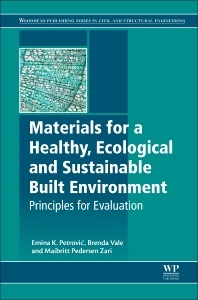Materials for a Healthy, Ecological and Sustainable Built Environment Principles for Evaluation Woodhead Publishing Series in Civil and Structural Engineering Series
Auteurs : Petrović Emina K., Vale Brenda, Pedersen Zari Maibritt

Principles for Evaluating Building Materials in Sustainable Construction: Healthy and Sustainable Materials for the Built Environment provides a comprehensive overview of the issues associated with the selection of materials for sustainable construction, proposing a holistic and integrated approach.
The book evaluates the issues involved in choosing materials from an ecosystem services perspective, from the design stage to the impact of materials on the health of building users.
The three main sections of the book discuss building materials in relation to ecosystem services, the implications of materials choice at the design stage, and the impact of materials on building users and their health. The final section focuses on specific case studies that illustrate the richness of solutions that existed before the rise of contemporary construction and that are consistent with a sustainable approach to creating built environments. These are followed by modern examples which apply some, if not all, of the principles discussed in the first three sections of the book.
Part I: Selecting Building Materials for Reduced Impacts on Ecosystem Services: Ecosystem Services Analysis1. Utilizing relationships between ecosystem services, built environments, and building materials2. Ecosystem services analysis: Incorporating an understanding of ecosystem services into built environment design and materials selection
Part II: Choosing Sustainable Materials3. Building materials4. Materials and buildings
Part III: Indoor Toxicity from Building Materials5. A lack of recognition of potential health risks from building materials6. Persisting issues with the most recognized building material health risks: Lead and asbestos7. How substances get regulated against in the building industry: Formaldehyde, phthalate plasticizers in polyvinyl chloride/vinyl8. New and less recognized risks with building materials: Volatile organic compounds, replacement chemicals, and nanoparticles9. An overview of health hazards from materials: Application of principles
Part IV: Case Studies10. Sustainability and the material aspect of traditional residential buildings in Serbia11. Palm thatched building in Mexico12. The effect of global trade on the New Zealand house13. Thurgoona Campus: A living laboratory of healthy and sustainable materials14. The Hockerton Housing Project: A case study of the use of concrete15. Lambie House: Deconstruction and eco-refurbishment16. Meridian: New Zealand’s first Green Star-rated building17. Sustainable and healthy building practice in Germany18. The Bullitt Center: A “Living Building
Architects, building science and materials studies, designers, specifiers and product manufacturers and all those involved in the built environment, construction and sustainable development.
Dr Emina Kristina Petrovic is recognised for her expertise on toxicity, sustainability, and healthiness of building materials. Petrovic emphasises the importance of informed building material selection for both the built and natural environment, calling for a more detailed consideration of building materials for the totality of their impacts, from ecosystem health to ethics of production. By asserting the relevance of the interrelatedness of these issues, Petrovic is providing a critical leadership in a transition to less impactful construction. Because knowledge itself is not enough for the needed change, Petrovic has also contributed a new sustainable transition framework, and examines aspects of behaviour change in building industry.
Brenda Vale is an architect and Professorial Research Fellow, at the School of Architecture, Victoria University of Wellington, New Zealand. Working with Robert Vale, she wrote her first book on sustainable design in 1975. Following their award winning and energy saving commercial buildings in the UK for which they were both the architects, by 1998 they had designed and built the award winning first autonomous house and the first zero-emissions settlement there. After coming to New Zealand in 1996 they converted an existing house to be zero energy. They also developed the Australian Government’s National Australian Built Environment Rating System (NABERS), now in operation. Their current research is in the field of ecological footprints and behaviour, which has led to two published books (Time to eat the dog? the real guide to sustainable living and Living within a fair share ecological footprint).
Maibritt Pedersen Zari is a Senior Lecturer in Sustainable Architecture at the School of Architecture, Victoria University of Wellington, New Zealand. She teaches both undergraduate and graduate programmes in Architecture, Interior Architecture, Building Science and Sustainable Engineering. Her areas of expertise are biomimi
- Provides a holistic and integrated approach to the issues associated with the selection of materials for sustainable construction
- Provides a thorough understanding of ecosystem services based on ecology research for built environment design
- Provides an original review of the impact of materials on human health
- Provides case studies to illustrate the points above
Date de parution : 03-2017
Ouvrage de 416 p.
15x22.8 cm
Thèmes de Materials for a Healthy, Ecological and Sustainable... :
Mots-clés :
Allergy-sensitive building; Architectural design; Asbestos; Biodiversity; Building materials; Building size; Bullitt Center; Carbon footprint; Carpets; Charles Sturt University; Climate change; Concrete; Deconstruction; Ecological design; Ecological footprint; Ecological impacts; Ecological value; Ecosystem services analysis (ESA); Embodied energy; Environmental impact; Environmentally Sustainable Design (ESD); Extracted materials; Formaldehyde; Grown materials; Healthy building materials; High-mass construction; Imports; Indoor air toxicity; Known hazards; Lead (Pb); Lifecycle analysis accuracy; Lifecycle energy; Lifecycle energy assessment; Linoleum; Living Building Challenge; Made materials; Manufacture; Material basis of traditional houses; Materials reuse; Materials selection; Nanoparticles; New Zealand Green Star rating; Office building design; Offices; Operating energy; Paints and varnishes; Palm thatching; Phthalate plasticizers; Polymers and biopolymers; Radon; Rammed earth construction; Recycled building materials; Recycling; Red List; Regenerative design; Replacement chemicals; Serbian vernacular; Stages of recognition of risks; Sustainable building certification; Sustainable building materials; Sustainable material selection; Thermal mass; Thurgoona Campus; Timber; Toxicity of building materials; Traditional architecture; Urban planning; User health; Vernacular traditions; Volatile organic compounds (VOCs); Waste minimization; Waste recovery; Whole building design; Zero-heating housing



